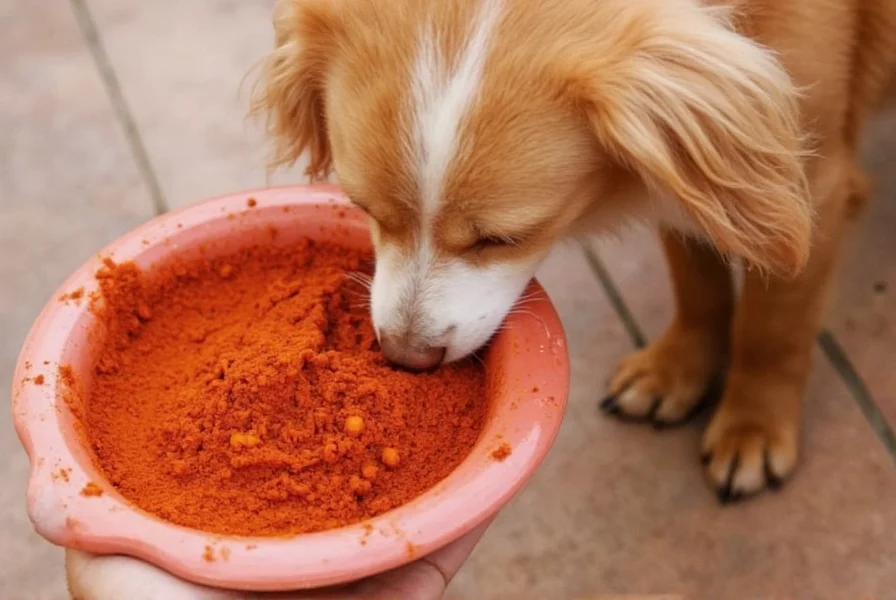As a pet owner, discovering your dog has eaten something potentially harmful can be alarming. Understanding the specific risks paprika poses to dogs is crucial for keeping your canine companion safe. This article provides evidence-based information about why paprika is dangerous for dogs and what steps you should take if accidental ingestion occurs.
Why Paprika Poses Serious Health Risks to Dogs
Paprika's primary danger comes from capsaicin, the compound that gives peppers their heat. Unlike humans, dogs lack the necessary receptors to process capsaicin effectively. When dogs consume paprika, they experience immediate burning sensations throughout their digestive tract.
Veterinary research shows that capsaicin triggers an inflammatory response in dogs' gastrointestinal systems. This inflammation leads to painful symptoms that can last for hours or even days depending on the amount consumed. The severity increases with the concentration of paprika—Hungarian paprika tends to be milder, while smoked or hot varieties contain higher capsaicin levels.

Symptoms of Paprika Exposure in Dogs
Dogs exposed to paprika typically show symptoms within 15-30 minutes. The table below outlines common reactions based on exposure level:
| Exposure Level | Common Symptoms | When to Seek Veterinary Care |
|---|---|---|
| Minor (small lick) | Drooling, pawing at mouth, mild stomach upset | Monitor for 24 hours; contact vet if symptoms worsen |
| Moderate (1-2 tsp) | Vomiting, diarrhea, lethargy, decreased appetite | Contact vet within 2 hours |
| Severe (1+ tbsp) | Severe vomiting/diarrhea, difficulty breathing, tremors | Seek emergency care immediately |
What to Do If Your Dog Eats Paprika
Immediate action can minimize your dog's discomfort and prevent complications. Follow these evidence-based steps:
- Remove remaining paprika - Clear any accessible spice to prevent further ingestion
- Offer cool water - Helps soothe mouth irritation (avoid milk as it can worsen digestive issues)
- Monitor symptoms - Note onset time and severity of reactions
- Contact your veterinarian - Provide details about the paprika type and estimated amount consumed
Never induce vomiting unless specifically instructed by a veterinary professional. Some substances can cause additional damage when vomited. Your vet may recommend activated charcoal or other treatments based on your dog's size and the amount consumed.
Understanding Canine Digestive Sensitivity
Dogs' digestive systems differ significantly from humans'. While we can tolerate moderate spice levels, dogs have more sensitive mucous membranes throughout their digestive tract. The American Veterinary Medical Association notes that dogs lack certain enzymes needed to break down capsaicin compounds effectively.
Research published in the Journal of Veterinary Pharmacology shows that capsaicin triggers an exaggerated inflammatory response in dogs' gastrointestinal systems. This explains why symptoms like vomiting and diarrhea occur even with small exposures to paprika. Smaller dog breeds and puppies face higher risks due to their reduced body mass.
Safer Alternatives for Flavoring Dog Food
If you're looking to enhance your dog's food flavor safely, consider these veterinarian-approved options:
- Parsley - Fresh or dried, helps with breath and provides vitamins
- Basil - Contains antioxidants with anti-inflammatory properties
- Ginger - Small amounts can aid digestion (¼ tsp for medium dogs)
- Turmeric - Anti-inflammatory benefits when combined with black pepper and healthy fat
Always introduce new flavors gradually and consult your veterinarian before making dietary changes, especially for dogs with existing health conditions. Remember that dogs don't require added flavors in their food—most commercial dog foods contain balanced nutrition without needing additional seasoning.
Preventing Accidental Paprika Exposure
Prevention remains the best approach for keeping your dog safe from harmful spices. Implement these practical strategies:
- Store spices in closed cabinets dogs cannot access
- Clean countertops thoroughly after cooking with spices
- Avoid seasoning food while dogs are nearby
- Educate family members about dangerous human foods for dogs
- Use pet-safe alternatives when cooking homemade dog treats
Particularly during holiday cooking seasons, be extra vigilant about spice safety. Many traditional recipes contain paprika and other potentially harmful ingredients that curious dogs might investigate.
Frequently Asked Questions
Is paprika toxic to dogs in small amounts?
While not technically toxic like chocolate or xylitol, even small amounts of paprika cause significant discomfort in dogs. A single lick can lead to mouth burning, excessive drooling, and stomach upset. The severity increases with the amount consumed, but no quantity is considered safe for canine consumption.
What should I do if my dog eats paprika-laced food?
First, remove any remaining food and offer cool water to soothe mouth irritation. Monitor for symptoms like vomiting or diarrhea. Contact your veterinarian with details about the food consumed and estimated paprika content. For significant exposures (more than a teaspoon), seek veterinary care within two hours to prevent complications.
How long do paprika symptoms last in dogs?
Most mild paprika reactions resolve within 24 hours with proper care. Moderate cases may take 48-72 hours for complete recovery. Severe exposures requiring veterinary intervention might need several days of supportive care. Persistent symptoms beyond 72 hours warrant immediate veterinary follow-up as they could indicate secondary complications.
Can dogs eat foods with paprika seasoning?
No, dogs should not consume any foods seasoned with paprika. Even when mixed with other ingredients, the capsaicin content remains problematic. Many seasoned dishes also contain additional harmful ingredients like garlic, onions, or excessive salt that compound the risks. Always serve dogs plain, unseasoned versions of human foods when sharing.
Are some paprika varieties safer for dogs than others?
No paprika variety is safe for dogs. Sweet Hungarian paprika contains lower capsaicin levels but still causes discomfort. Smoked paprika and hot paprika varieties pose even greater risks due to higher capsaicin concentrations. All forms of paprika—whether sweet, smoked, or hot—should be kept away from dogs to prevent adverse reactions.











 浙公网安备
33010002000092号
浙公网安备
33010002000092号 浙B2-20120091-4
浙B2-20120091-4